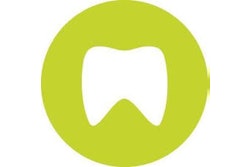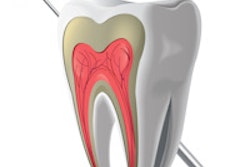
A California company has created an experimental crown and bridge restorative material that is free of bisphenol A (BPA) and performed well when compared to two currently available commercial products in strength testing.
Danville Materials, a dental equipment and materials company, presented its findings during a poster session at the recent American Association for Dental Research (AADR) annual session in Tampa, FL.
"We were very pleased to see that we could make a material that didn't incorporate those resins and performed comparably," Nick Aralis, a chemist at Danville, said during an interview with DrBicuspid.com.
The researchers at Danville tested their experimental material against two Bisacryl-type commercially available temporary restorative materials, Luxatemp Fluorescence (DMG America) and Protemp Plus (3M ESPE), and found that "all of the tested parameters in the experimental material were equivalent to at least one of the compared commercial materials."
The concept for the material arose while Danville was developing Turbo Temp 3, a 10:1 temporary crown and bridge material launched in January. Like many companies in the industry, Danville was paying attention to the growing amount of data concerning BPA.
"We've noticed that there has been a lot of talk in the marketplace about BPA, its effects, and its place in dental sealants," Aralis said.
One study, published in Pediatrics, was particularly impactful. According to the researchers, more than 95% of U.S. residents have traceable amounts of BPA in their urine, despite the compound's short half-life (Peds, Oct. 2010, Vol. 126:4, pp. 760-768).
"While contaminated food is a popular thing to attribute that to, even after fasting, detectable levels [of BPA] remained in those who were tested," Aralis noted. "It goes to show that there are other sources out there, and dental is definitely one of them."
While the effects of BPA on human health remain unclear, companies in and outside of dentistry are working to remove it from their products. Some, such as Ultradent Products, have already released BPA-free sealants. "It seems to be growing in popularity, with Heraeus Kulzer changing their system all over to BPA-free; Dentsply has some BPA-free products, as well," Aralis said.
3 materials put to the test
Most commercial, two-part provisional crown and bridge restoratives contain resins that have BPA components, Aralis and his colleague wrote in the study's introduction. Its presence contributes to key properties that an effective provisional crown and bridge material has, such as high flexural and compressive strength, high hardness, a prompt and well-defined setting profile, and low water absorption.
Using International Organization for Standardization and ADA methods, the researchers ran the three materials through several tests.
Luxatemp Fluorescence had a slightly higher 24 hour flexural strength than Protemp Plus and the experimental material; the latter two were not significantly different (p > 0.05). The results were the same in the water absorption test: Luxatemp Fluorescence slightly outperformed the other two materials, which were statistically similar.
Protemp Plus had about 15% higher compressive strength than the other materials, which were statistically similar (p > 0.05). However, the other materials performed slightly better than Protemp Plus in the barcol hardness test. In addition, the flexural modulus of all three materials was statistically the same; the measured exotherm was, as well.
"Work-time, exotherm, water-absorption -- those three in particular -- as well as strength properties were aspects of the material we worried could be affected in a negative way by a change in the resin system," Aralis noted. "We found that we were able to manipulate the system and use the technology employed in our Turbo Temp3 to get a product that gave us results similar to either Luxetemp or Protemp Plus in all of those categories."
While the results were promising, there is more work to be done, such as a biological study.
"We would like to conduct an investigation that actually measures the leaching to see if there are any other detectable things that could be unaccounted for, which we don't expect since the material wasn't composed of BPA," Aralis said. "Also, further physical properties testing, such as fracture toughness testing, polish retention, and seeing how it performs in the mouth in terms of allowing bacteria to attach to it."
Aralis would not comment on Danville's intentions of releasing the material to the market. However, he said, "It is something we could very well see in the near future."



















